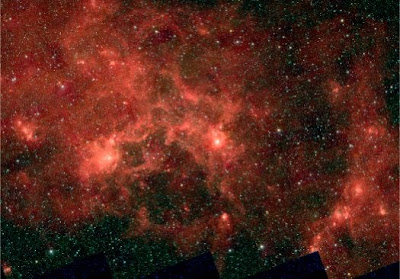The Dragonfish star cluster is a group of very massive stars that are embedded in a thin bubble of gas from which they formed. This cluster was recently discovered using the Spitzer Space Telescope, and further studied using the New Technology Telescope in Chile. It's name comes from the fact that the shell of gas (bottom middle) resembles the snarling mouth of a dragonfish. This cluster is made up of many massive stars, some of which may even be 100x the size of our sun! The region around the fishes eye (bright star in the middle) contains more gas and could still be forming stars. Stars this massive don't live very long, so it's likely that star formation in this region won't last very long, as a supernova explosion could blow away most of the material in the next few million years!
Image Credit: NASA/JPL-Caltech/GLIMPSE Team/Mubdi Rahman


